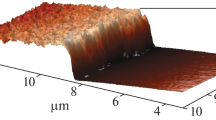Abstract
Studies have been made on the dependence of carbon-film resistivity on deposition temperature (20–650 °C) and magnetron discharge power (50–650 W). Electron diffraction and Raman scattering have been used to examine the film structure. The results suggest that the structure is formed mainly by carbon atoms with sp2 bonding. In the range 20–450 °C, aromatic rings are formed together with graphitic clusters, and the degree of ordering increases with the condensation temperature. At T ≥ 500 °C, there is a change in the mechanism of C film growth, and graphitic-phase nuclei are formed and grow directly on the substrate. At a sufficiently high magnetron discharge power, there is uncontrolled heating of the condensation surface in the deposition of carbon films on ceramic substrates with low thermal conductivity. The growing film is affected by two competing processes: the temperature rise in the substrate favors graphitization, while the increase in the energy of the particles forming the film causes disordering. In the power range 50–400 W, the substrate temperature effect predominates, but above 400 W, the particle energy effect does.
Similar content being viewed by others
REFERENCES
S. Anders, J. W. Ager III, G. M. Pharr, et al., “Heat treatment of cathodic arc deposited amorphous hard carbon films,” Thin Solid Films, 308–309, 186–190 (1997).
M. Chhowalla, A. C. Ferrary, J. Robertson, and G. A. J. Amaratunga, “Evolution of sp 2 bonding with deposition temperature in tetrahedral amorphous carbon studied by Raman spectroscopy,” Appl. Phys. Lett., 76, 1419–1421 (2000).
M. A. Capano, N. T. McDevitt, R. K. Singh, and F. Qian, “Characterization of amorphous carbon thin films,” J. Vac. Sci. Technol., A14, No.2, 431–435 (1996).
I. Alexandrou, H.-J. Scheibe, C. J. Kiely, et al., “Carbon films with an sp 2 network structure,” Phys. Rev. B, 60, No.15, 10903–10907 (1999).
Y. Lifshitz, G. D. Lempert, S. Rotter, et al., “The influence of substrate temperature during ion beam deposition on the diamond-like or graphitic nature of carbon films,” Diamond Relat. Mater., 2, No.2–4, 285–290 (1993).
H. Hofsass, H. Binder, T. Klumpp, and E. Recknagel, “Doping and growth of diamond-like carbon films by ion beam deposition,” Diamond Relat. Mater., 3, No.1–2, 137–142 (1994).
J. J. Cuomo, D. L. Pappas, J. Bruley, et al., “Vapor deposition processes for amorphous carbon films with sp 3 fractions approaching diamond,” J. Appl. Phys., 70, No.3, 1706–1711 (1991).
E. Mounier, F. Bertin, M. Adamik, et al., “Effect of substrate temperature on the physical characteristics of amorphous carbon films deposited by dc magnetron sputtering,” Diamond Relat. Mater., 5, No.12, 1509–1515 (1996).
J. Fetter, M. Stuber, and S. Ulrich, “Growth effects in carbon coatings deposited by magnetron sputtering,” Surf. Coat. Technol., 168, 169–178 (2003).
L. R. Shaginyan, A. A. Onoprienko, V. F. Britun, and V. P. Smirnov, “Influence of different physical factors on microstructure and properties of magnetron sputtered amorphous carbon films,” Thin Solid Films, 397, 288–295 (2001).
Y. Lifshitz, G. D. Lempert, S. Rotter, et al., “The effect of ion energy on the diamond-like/graphitic (sp 3/sp 2) nature of carbon films deposited by ion beams,” Diamond Relat. Mater., 3, 542–546 (1994).
Y. Lifshitz, “Diamond-like carbon-present status,” Diamond Relat. Mater., 8, 1659–1676 (1999).
A. C. Ferrary and J. Robertson, “Interpretation of Raman spectra of disordered and amorphous carbon,” Phys. Rev. B, 61, No.20, 14095–14107 (2000).
S. Bhargava, H. D. Bist, S. B. Samanta, et al., “Nanoclusters in laser ablated diamond-like carbon films through scanning tunneling microscopy,” J. Appl. Phys., 90, No.3, 205–209 (1996).
T. A. Friedman, K. F. McCarty, J. C. Barbour, et al., “Thermal stability of amorphous carbon films grown by pulsed laser deposition,” Appl. Phys. Lett., 68, No.12, 1643–1645 (1996).
A. A. Onoprienko, V. V. Artamonov, and I. B. Yanchuk, “Effect of deposition and anneal temperature on the resistivity of magnetron sputtered carbon films,” Surf. Coat. Tech., 172, 189–193 (2003).
A. Zeng, E. Liu, S. Zhang, et al., “Impedance study on electrochemical characteristics of sputtered DLC films,” Thin Solid Films, 426, 258–264 (2003).
Author information
Authors and Affiliations
Additional information
__________
Translated from Poroshkovaya Metallurgiya, Nos. 9–10(445), pp. 106–113, September–October, 2005.
Rights and permissions
About this article
Cite this article
Onoprienko, A.A., Yanchuk, I.B. Effects of Deposition Conditions on Carbon-Film Resistivity and Microstructure. Powder Metall Met Ceram 44, 499–504 (2005). https://doi.org/10.1007/s11106-006-0015-z
Received:
Issue Date:
DOI: https://doi.org/10.1007/s11106-006-0015-z




